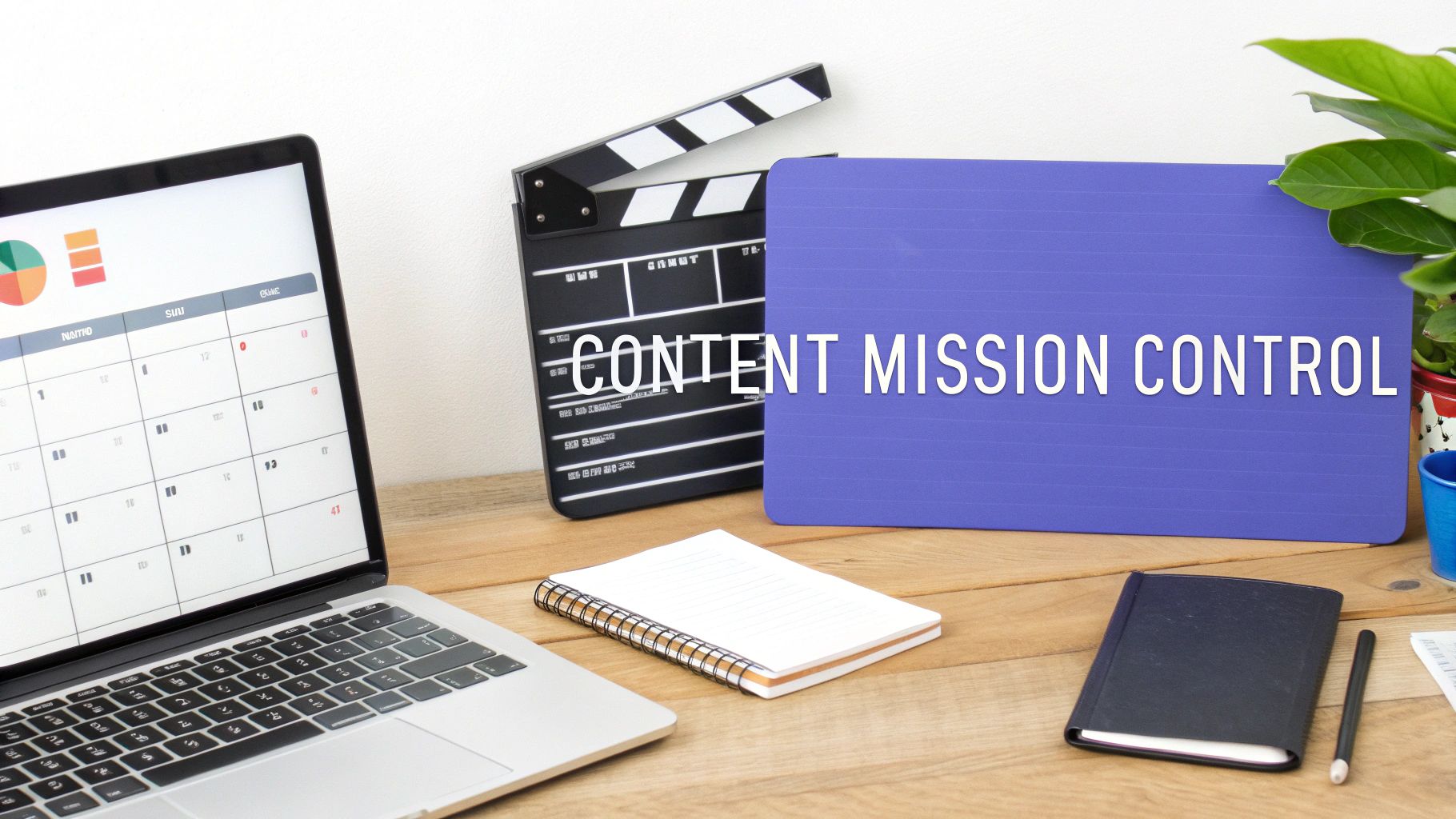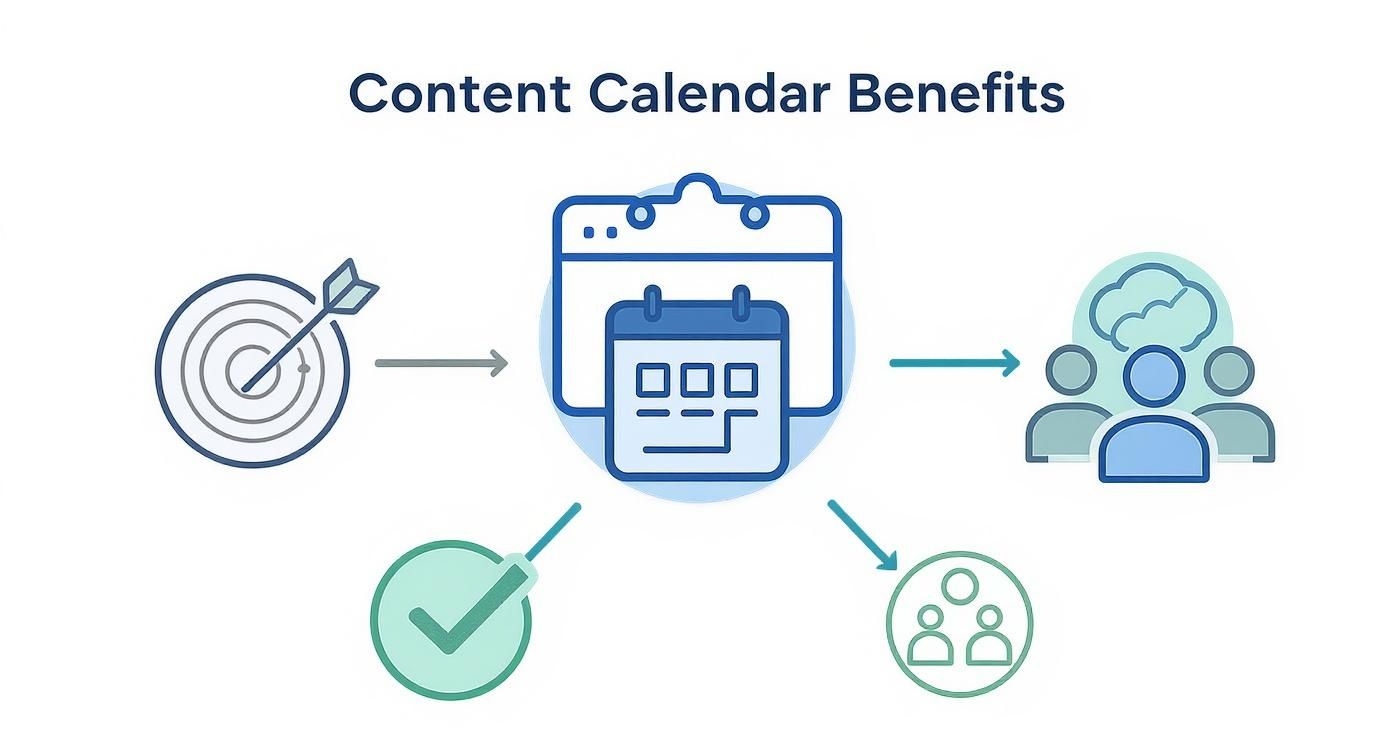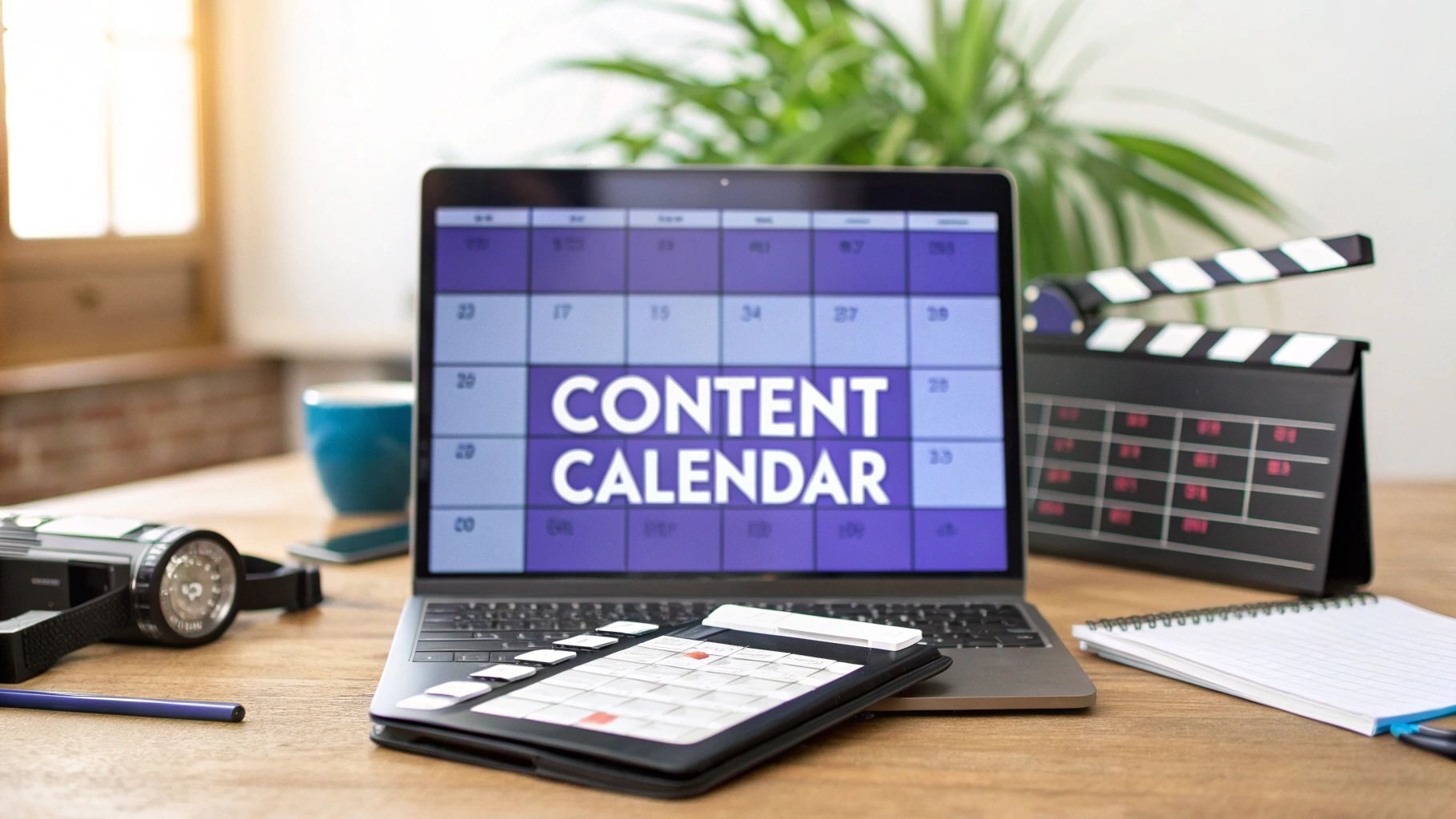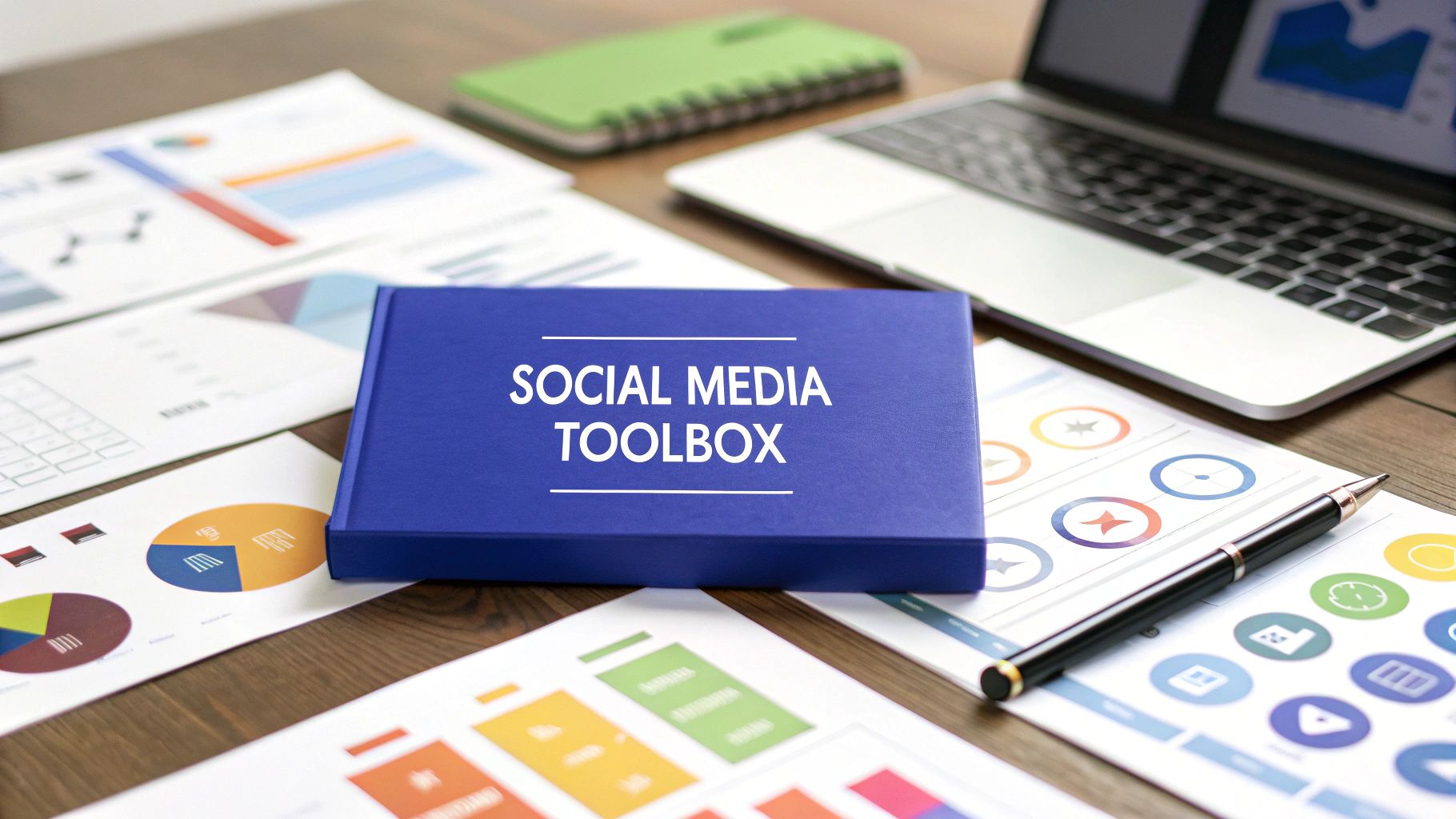Ever feel like your content efforts are a bit... chaotic? A blog post here, a social media update there, with no real rhythm or reason. A content calendar is what turns that chaos into a finely tuned marketing machine.
Think of it as the mission control for your entire content strategy. It's not just a to-do list; it’s a strategic command center where you plan, organize, and schedule everything you create, from in-depth articles to quick-fire tweets. It gives you a bird's-eye view of your whole operation, ensuring every piece of content has a purpose.

What Is a Content Calendar Really?
Let's use an analogy. Imagine a film director trying to make a movie without a production schedule. Actors would show up on the wrong days, the crew wouldn't have the right equipment, and the final cut would be a jumbled mess. A content calendar does for your marketing what that schedule does for a film: it coordinates all the moving parts to create a cohesive, compelling final product that gets delivered on time.
This is the single source of truth that transforms random, last-minute scrambling into a well-oiled campaign. Understanding this is a core part of figuring out what is content marketing in the first place. The calendar is the practical framework that brings your grand strategy to life.
From Simple Schedule to Strategic Command Center
Years ago, a content calendar might have just been a spreadsheet with a few dates. Today, it’s so much more. Modern content calendars are dynamic, collaborative workspaces where entire teams can align on goals, track progress in real-time, and actually measure the impact of their work.
This evolution makes sense when you consider the stakes. The global content marketing industry is expected to hit $107.5 billion by 2026, which tells you just how much businesses are investing in organized, high-quality content.
A great content calendar turns your content from a series of random acts into a deliberate, goal-driven strategy. It’s the difference between hoping for results and planning for them.
This becomes especially vital when you're juggling different platforms, each with its own audience and best practices. For a closer look at how this works for a specific channel, our guide on building a social media content calendar breaks it down perfectly. The principles are always the same: plan ahead, stay organized, and execute with precision.
Ultimately, a content calendar boils down to four essential functions that work together to keep your marketing on track.
Core Functions of a Content Calendar at a Glance
This table breaks down the four primary roles a content calendar plays in any successful marketing strategy. Think of it as a quick reference for its key benefits.
| Function | What It Means | Key Benefit |
|---|---|---|
| Planning | Strategically mapping out future content topics and campaigns. | Ensures content aligns with business goals and audience needs. |
| Organization | Keeping all content-related assets and information in one place. | Reduces chaos and saves time searching for files or details. |
| Collaboration | Providing a shared view for teams to coordinate tasks and approvals. | Improves team communication and streamlines the entire workflow. |
| Tracking | Monitoring the status of each content piece from idea to publication. | Gives clear visibility into progress and helps identify bottlenecks. |
By centralizing these four pillars, a content calendar does more than just organize your posts—it empowers your entire team to work smarter, not harder.
Of course. Here is the rewritten section, crafted to sound completely human-written and natural, following the provided style guide.
Why a Content Calendar Is Your Secret Weapon
We all know what a content calendar is, but the real magic happens when you see the problems it solves firsthand. Without one, you’re probably trapped in a reactive loop, scrambling to create content at the last minute. This frantic approach almost always leads to inconsistent posting, rushed work, and messaging that feels disjointed or completely off-brand.
Think about that Monday morning chaos. The dreaded "What are we posting this week?" panic is stressful and, frankly, ineffective. A content calendar completely flips the script. That stressful question becomes a calm statement: "Here's what's going live this week, and it’s all ready to go." It’s your secret weapon against the chaos that kills great content strategies before they even get started.
This proactive mindset is what prevents those awkward "content gaps"—the long silences on your blog or social media that can make your brand look like it’s gone dark. When you show up consistently with high-quality content, you build trust and keep your audience hooked, turning casual followers into loyal fans.
From Burnout to Strategic Growth
The pain of being disorganized hits everyone a little differently depending on their role, but it’s always damaging. A good content calendar pinpoints these specific challenges and turns them into opportunities for growth.
For the solo creator or influencer, it’s a lifesaver that prevents burnout. When you're juggling ideas, creation, and promotion all by yourself, it’s beyond exhausting. A calendar gives you structure, letting you batch tasks and escape the constant pressure of dreaming up a new idea every single day.
For small business marketing teams, it’s all about alignment. On a small team, everyone wears multiple hats. A shared calendar gets everyone on the same page, stops duplicate work in its tracks, and makes sure every single piece of content is driving toward the same goal, like an upcoming product launch.
A content calendar isn't just about scheduling posts; it's about scheduling success. It ensures that every piece of content you create is a deliberate step toward a larger business objective, not just noise.
Unifying Efforts for Maximum Impact
As organizations get bigger, the benefits just multiply. In an enterprise setting, a content calendar is the central hub that holds complex, multi-channel campaigns together across different departments. It stops teams from sending conflicting messages and ensures a single, cohesive brand story is told everywhere—from a global product launch down to a regional social media update.
Digital marketing agencies live and die by their content calendars. They use them to manage dozens of client accounts with total clarity and professionalism. It becomes the command center for planning, getting client approvals, and tracking performance, proving their strategic value and keeping every project on schedule.
At the end of the day, a content calendar solves some of the most universal problems in business:
- It eliminates inconsistency. By planning ahead, you maintain a steady, reliable presence that builds audience expectations and trust.
- It streamlines collaboration. Everyone knows their role, deadlines are crystal clear, and the approval process is transparent. Less internal friction, more great work.
- It ensures strategic purpose. Each piece of content is tied to a specific goal, whether that’s driving traffic, generating leads, or building brand awareness.
By shifting from a frantic, day-to-day grind to a strategic, long-term view, you turn your content from a bunch of random posts into a powerful engine for business growth. It's a simple tool that empowers you to be intentional, organized, and consistently effective.
The Anatomy of a High-Impact Content Calendar
A truly effective content calendar is way more than just a list of dates and topics. Think of it less like a simple schedule and more like a detailed blueprint for your entire content operation. When you move beyond a basic to-do list, your calendar transforms from a simple tracking sheet into a powerful asset that actually drives results.
Sure, its core job is straightforward: know what is being published and when. But a high-impact calendar answers the deeper questions: Why are we creating this piece? Who is it for? And how are we going to make sure it succeeds? Answering these requires adding specific, purposeful details that connect every single article, video, or post back to your bigger goals.
This flowchart breaks down the core benefits you get from a well-structured calendar, from keeping your posting schedule consistent to getting your entire team aligned and collaborating smoothly.

As you can see, a central calendar branches out to support key business functions. It really does act as the command center for your whole content strategy.
So, what exactly goes into one of these? Let's break it down into the must-haves and the "pro-level" additions.
The Non-Negotiables: Core Components
Every content calendar, no matter how simple, starts with the fundamentals. These are the fields that give you at-a-glance clarity and keep the content machine from grinding to a halt. Think of them as the essential columns in your spreadsheet or the required fields in a project management tool.
Without these basics, chaos is pretty much guaranteed. They ensure everyone knows what’s happening, who’s responsible, and where each piece of content is in the production line.
Level Up: Advanced Strategic Fields
To take your calendar from a simple schedule to a genuine strategic tool, you need to add another layer of detail. These advanced fields are what connect your day-to-day content creation to your larger business objectives, making sure every piece of work has a clear purpose and a way to measure its impact.
These fields provide the "why" behind your content. They link individual posts to broader campaigns and tie your effort directly to results. This is how you start proving the ROI of your content and making smarter, data-driven decisions about what to create next.
A great content calendar doesn't just manage tasks; it visualizes strategy. By including fields for KPIs and promotion, you force yourself to think about a piece of content's entire lifecycle, not just its publication date.
The table below breaks down both the essential and the advanced components. Use it as a blueprint to build a calendar that gives you a 360-degree view of your content operations.
Essential Components of a Content Calendar
Here’s a detailed breakdown of the key fields to include in your content calendar, explaining the purpose of each and providing a practical example.
| Component | Purpose | Example Entry |
|---|---|---|
| Publication Date | The day the content goes live, creating a predictable schedule. | 10/28/2025 |
| Topic/Headline | Clearly defines what the content is about. | "5 Ways to Boost Instagram Engagement" |
| Content Owner | Assigns direct responsibility for the piece from start to finish. | Sarah Jenkins |
| Current Status | Tracks progress and identifies bottlenecks in the workflow. | In Review |
| Target Keyword | Aligns content with SEO goals to attract organic traffic. | "social media content tips" |
| Target Persona | Ensures the content is tailored to the right audience segment. | Small Business Marketer |
| Promotion Channels | Plans how and where the content will be distributed after publishing. | LinkedIn, Twitter, Email Newsletter |
| Target KPIs | Defines what success looks like for this specific piece of content. | 1,000 pageviews, 50 newsletter sign-ups |
By building out your calendar with these components, you're not just planning what to post—you're building a strategic engine for your entire marketing effort.
How to Build Your First Content Calendar
Building your first content calendar can feel like a monster task, but it’s actually way simpler than you think. The trick is to focus on your strategy before you even think about tools or dates. A calendar without a clear purpose is just a glorified to-do list; a strategic one becomes the blueprint for your growth.
Before you open a spreadsheet or sign up for a new tool, you have to lay the groundwork. This initial planning is what separates a calendar that just organizes tasks from one that actively drives business results. It all starts by answering a few fundamental questions about what you want to achieve.

Getting this right ensures every single piece of content you create is intentional, targeted, and measurable.
Start with Strategic Foundations
First things first: what does success actually look like? Are you trying to drive more traffic, generate leads, or just build brand awareness? Your main goal is going to shape every other decision you make.
Next, get laser-focused on who you're talking to. You have to understand your audience’s pain points, questions, and interests if you want to brainstorm topics that genuinely connect. If you don't know who you're creating for, your content is just a shot in the dark.
With your goals and audience clear, you can start mapping out your core content pillars. These are the 3-5 main topics or themes your brand is going to own. For a fitness brand, these might be "Nutrition," "Workout Routines," and "Mindfulness." Pillars give your content structure and keep you from drifting off-topic.
A content calendar built on a weak foundation is destined to fail. Take the time to define your goals, audience, and content pillars first. This strategic clarity will make the actual planning process faster, easier, and far more effective.
Choose the Right Format for You
Once your strategy is locked in, it’s time to pick your tool. Honestly, the "best" format is simply the one your team will actually use. Don’t get caught up in fancy features if a simple spreadsheet gets the job done.
Here are a few popular options, from the dead-simple to the more advanced:
- Spreadsheets (Google Sheets or Excel): The perfect starting point for beginners. It's free, completely customizable, and everyone knows how to use it. You can build columns for all your essential details and share it instantly.
- Project Management Tools (Trello or Asana): These platforms are more visual and collaborative. Using Kanban boards to track content from "Idea" to "Drafting" to "Published" is a game-changer for many teams.
- Dedicated Content Platforms (like PostSyncer): For teams that are all-in on social media, a specialized tool is often the smartest choice. These platforms combine scheduling, approvals, and analytics in one spot, which saves a ton of time.
Content calendars have become standard practice for a reason. In fact, by 2025, a whopping 42% of marketing teams plan to update their content strategy every single quarter, and they're using calendars to manage all those moving parts.
The tool itself is less important than the process you build around it. For a step-by-step walkthrough, check out our in-depth guide to content calendar creation that covers everything from ideation to hitting "publish." The real goal here is to build a system that brings immediate order and clarity to your workflow, no matter what your budget or team size looks like.
Best Practices for Managing Your Calendar
So, you've built a content calendar. That's a huge first step. But the real test? Turning that static document into the living, breathing heart of your content operation.
If you’re not careful, even the most beautifully designed calendar can turn into a digital ghost town—a relic of good intentions that no one actually uses. The goal is to make it the one indispensable tool your team can't live without.
This all comes down to building clear, repeatable habits. From the spark of an idea to the final analytics report, every step needs to be defined. Get this right, and you’ll create a predictable rhythm that kills last-minute scrambles and makes your entire content process run smoothly.
Establish a Clear Content Workflow
A great calendar is built on the foundation of a rock-solid workflow. Think of it as the assembly line for your content, spelling out exactly who does what and when. A well-oiled workflow moves content through distinct stages, ensuring nothing falls through the cracks.
A typical workflow should cover stages like these:
- Ideation: The freewheeling stage where new topics are pitched, debated, and chosen.
- Drafting: Boots on the ground. The writer is writing, the designer is designing, the videographer is shooting.
- Review: The first set of eyes. Editors or peers check for quality, accuracy, and brand voice.
- Approval: The final gatekeeper. Stakeholders give the official thumbs-up before it goes live.
- Publishing: Go time! Pushing the content out to its intended channels.
When everyone knows their role, bottlenecks disappear. You can dive deeper into creating this kind of structured system in our guide to building a strong content approval process.
Build in Flexibility and Stay Agile
While structure is your best friend, a content calendar shouldn't be a rigid prison. The digital world doesn't wait for anyone. You have to be ready to jump on trending topics, breaking news, or a surprise opportunity that drops into your lap.
The best calendars masterfully balance long-term strategic planning with short-term agility.
An easy way to do this is to build "flex spots" directly into your schedule. Pencil in a few slots each month for "reactive" or "timely" content. This gives you the freedom to join a viral conversation without throwing your entire planned schedule into chaos.
Think of your calendar as a GPS, not a train track. It gives you the best route to your destination, but you need the freedom to take a detour when a golden opportunity pops up.
Make Your Calendar a Visual Hub
In a busy workflow, clarity is everything. Your calendar should be understandable at a single glance, and visual cues are the fastest way to get there.
Color-coding is a simple but incredibly powerful trick. Assign different colors to key identifiers:
- Content Format: Blogs are blue, videos are red, social posts are green.
- Campaign Theme: Product Launch A is purple, Q4 Holiday Push is orange.
- Status: Yellow for "In Progress," gray for "In Review," and a satisfying dark green for "Published."
This kind of visual organization helps your team instantly see what’s happening without having to click into every single card. The easier your calendar is to read and use, the more likely your team is to actually use it.
Of course, a great calendar is only half the battle—the content you're planning has to deliver. Weaving in proven content creation best practices from the start will turn your schedule from a simple planning document into a strategic tool for genuine growth.
Common Questions About Content Calendars, Answered
Once you get the hang of what a content calendar is, the practical questions start bubbling up. This is totally normal. Think of this section as your quick-reference guide for turning that "aha!" moment into confident, real-world action.
We've pulled together the most common questions we hear to clear up any lingering confusion. How do you juggle different types of content? How far out should you actually be planning? And where on earth do you find a steady stream of ideas? Getting these answers straight is what turns a simple calendar into your most powerful marketing tool.
Social Media Calendar vs. Content Calendar
This one comes up a lot. It's a simple distinction, but getting it right helps your whole strategy click into place.
A content calendar is your master plan—the big picture. It maps out every single piece of content you create, no matter the channel. We’re talking blog posts, YouTube videos, email newsletters, case studies, and yes, social media. It’s the 30,000-foot view of your entire content universe.
A social media calendar is a specialized, focused piece of that bigger puzzle. It zooms in on just your social platforms, detailing the specific posts, captions, hashtags, and timing for each network.
Think of it like this: your content calendar is the blueprint for building an entire house. The social media calendar is the detailed plan for wiring just the electrical outlets.
How Far Ahead Should You Plan?
Figuring out your planning window is a balancing act between strategy and agility. Honestly, there's no single "right" answer—it really depends on your team's size and how complex your marketing efforts are.
- For most businesses and creators: Planning one month ahead in detail is the sweet spot. It gives you enough structure to stay on track without being so rigid that you can't react to a trending topic. You can pair this with a looser quarterly plan that outlines major themes or product launches.
- For agencies or large enterprises: It’s common to plan on a quarterly or even semi-annual basis. With multiple departments, bigger budgets, and complex campaigns, that longer runway is essential for aligning teams and locking down resources way in advance.
Finding a Never-Ending Stream of Ideas
Staring at a blank calendar is daunting for anyone. The secret isn't to be a creative genius 24/7; it's to build a system for generating ideas so you're never starting from scratch.
Start by just listening. What are the most common questions your customers ask? What are their biggest headaches? SEO tools are great for uncovering what people are actively searching for online. And don't be afraid to peek at what your competitors are doing—it's one of the best ways to spot content gaps you can fill.
Finally, look at your own greatest hits. That blog post that got tons of traffic? Turn it into a video, an infographic, or a series of social media tips. Repurposing your best content is the fastest way to get more value from the work you've already done.
Ready to put these answers into practice? PostSyncer gives you a powerful, AI-driven platform with drag-and-drop calendars, collaboration tools, and automated scheduling to make your content strategy a reality. Start your free 7-day trial and build a better calendar today.















